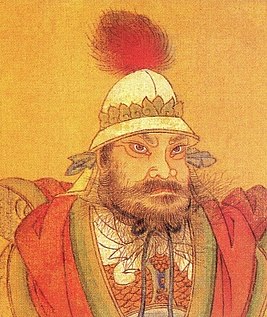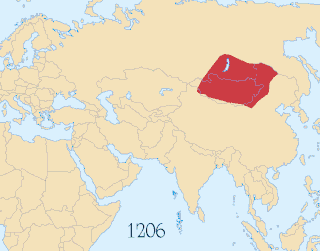
Jiankang, or Jianye, as it was originally called, was the capital city of the Eastern Wu, the Jin dynasty and the Southern Dynasties. Its walls are extant ruins in the modern municipal region of Nanjing.
There are traditionally four historical capitals of China, collectively referred to as the "Four Great Ancient Capitals of China". The four are Beijing, Nanjing, Luoyang and Xi'an (Chang'an).
The history of the administrative divisions of the Imperial China is quite complex. Across history, what is called 'China' has taken many shapes, and many political organizations. For various reasons, both the borders and names of political divisions have changed—sometimes to follow topography, sometimes to weaken former states by dividing them, and sometimes to realize a philosophical or historical ideal. For recent times, the number of recorded tiny changes is quite large; by contrast, the lack of clear, trustworthy data for ancient times forces historians and geographers to draw approximate borders for respective divisions. But thanks to imperial records and geographic descriptions, political divisions may often be redrawn with some precision. Natural changes, such as changes in a river's course, or loss of data, still make this issue difficult for ancient times.
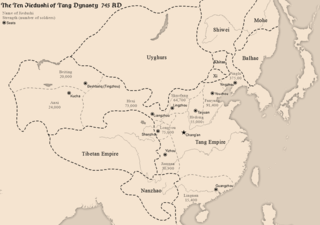
The jiedushi were regional military governors in China during the Tang dynasty and the Five Dynasties and Ten Kingdoms period. The post of jiedushi has been translated as "military commissioner", "legate", or "regional commander". Originally introduced in 711 to counter external threats, the jiedushi were posts authorized with the supervision of a defense command often encompassing several prefectures, the ability to maintain their own armies, collect taxes and promote and appoint subordinates.
Yan Rou was a military general of the state of Cao Wei during the Three Kingdoms period of China. He previously served under the warlord Cao Cao in the late Eastern Han dynasty.
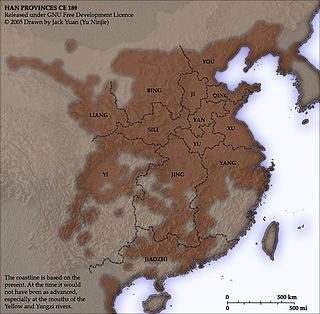
You Prefecture or Province, also known by its Chinese name Youzhou, was a prefecture (zhou) in northern China during its imperial era.
The city of Beijing has a long and rich history that dates back over 3,000 years. Prior to the unification of China by the First Emperor in 221 BC, Beijing had been for centuries the capital of the ancient states of Ji and Yan. During the first millennia of imperial rule, Beijing was a provincial city in northern China. Its stature grew in the 10th to the 13th centuries when the nomadic Khitan and forest-dwelling Jurchen peoples from beyond the Great Wall expanded southward and made the city a capital of their dynasties, the Liao and Jin. When Kublai Khan made Dadu the capital of the Mongol-led Yuan dynasty (1279–1368), all of China was ruled from Beijing for the first time. From 1279 onward, with the exception of two interludes from 1368 to 1420 and 1928 to 1949, Beijing would remain as China's capital, serving as the seat of power for the Ming dynasty (1421–1644), the Manchu-led Qing dynasty (1644–1912), the early Republic of China (1912–1928) and now the People's Republic of China (1949–present).

The Sixteen Prefectures, more specifically the Sixteen Prefectures of Yan and Yun or the Sixteen Prefectures of You and Ji, comprise a historical region in northern China along the Great Wall in present-day Beijing and Tianjin Municipalities and northern Hebei and Shanxi Province, that were ceded by the Shatuo Turk Emperor Shi Jingtang of the Later Jin to the Khitan Liao dynasty in 938. The subsequent Later Zhou and Song Dynasties sought to recover the ceded northern territories. Most of the Sixteen Prefectures including the two principal cities, Youzhou and Yunzhou remained in Liao hands until the 1120s, when the Jurchens of the Jin dynasty conquered the region. In 1123, the Jurchens ceded most of the territories except Yunzhou to the Song, but retook them in 1125. The loss of the Sixteen Prefectures exposed the plains of central China to further incursions by the Jurchens and the Mongols.
Luo Yi, known during service to Tang Dynasty as Li Yi (李藝), courtesy name Ziyan (子延) or Ziting (子廷), was a Sui Dynasty official who rose against the rule of Emperor Yang of Sui and occupied the modern Beijing region. He subsequently submitted to Emperor Gaozu of Tang and was created the Prince of Yan and granted the imperial surname of Li. He subsequently, in the struggle between Emperor Gaozu's sons Li Jiancheng the Crown Prince and Li Shimin the Prince of Qin, joined Li Jiancheng's faction. After Li Shimin killed Li Jiancheng in 626 and forced Emperor Gaozu to yield the throne to him, Li Yi was fearful, and he rebelled against Emperor Taizong in 627. He was soon defeated and killed.
Yuzhou or Yu Province was one of the Nine Provinces of ancient China, later to become an administrative division around the reign of Emperor Wu of the Western Han dynasty.
The Shangdang Prefecture or commandery, was an administrative subdivision of ancient China from the time of the Spring and Autumn period. Consisting of a number of districts or Zhōu (州), the prefecture covered roughly the area of modern-day Changzhi City in south east Shanxi Province.
"Beijing" is the atonal pinyin romanisation of the Mandarin pronunciation of the Chinese characters 北京, the Chinese name of the capital of the People's Republic of China.
Jingzhou or Jing Province was one of the Nine Provinces of ancient China referenced in Chinese historical texts such as the Tribute of Yu, Erya and Rites of Zhou. It became an administrative division during the reign of Emperor Wu in the Western Han dynasty.
Ji or Jicheng was an ancient city in northern China, which has become the longest continuously inhabited section of modern Beijing. Historical mention of Ji dates to the founding of the Zhou Dynasty in about 1045 BC. Archaeological finds in southwestern Beijing where Ji was believed to be located date to the Spring and Autumn period. The city of Ji served as the capital of the ancient states of Ji and Yan until the unification of China by the Qin Dynasty in 221 BC. Thereafter, the city was a prefectural capital for Youzhou through the Han Dynasty, Three Kingdoms, Western Jin Dynasty, Sixteen Kingdoms, Northern Dynasties, and Sui Dynasty. With the creation of a Jizhou (蓟州) during the Tang Dynasty in what is now Tianjin Municipality, the city of Ji took on the name Youzhou. Youzhou was one of the Sixteen Prefectures ceded to the Khitans during the Five Dynasties. The city then became the southern capital of the Liao Dynasty and then main capital of the Jin Dynasty (1115-1234). In the 13th Century, Kublai Khan built a new capital city for the Yuan Dynasty adjacent to Ji to the north. The old city of Ji became a suburb to Dadu. In the Ming Dynasty, the old and new cities were merged by Beijing's Ming-era city wall.
Yangzhou, Yangchow or Yang Province was one of the Nine Provinces of ancient China mentioned in historical texts such as the Tribute of Yu, Erya and Rites of Zhou.
Xuzhou as a historical toponym refers to varied area in different eras.
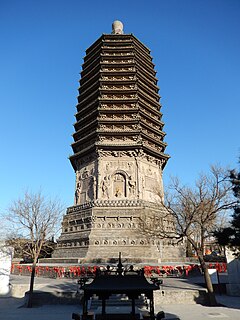
Nanjing was the name for modern Beijing during the Liao dynasty, when Khitan rulers made the city the southern capital. To distinguish Nanjing, which literally means "Southern Capital" in Chinese, from modern Nanjing in Jiangsu Province and Beijing Damingfu, the Northern Song Dynasty name for modern Daming County in Hebei Province, Chinese historians sometimes refer to Beijing during the Liao dynasty as Liao Nanjing. The Khitan rulers of the Liao acquired the city, then known as Youzhou, in the cession of the Sixteen Prefectures in 938 from the Later Jìn, one of the five shortlived dynasties that ruled northern China following the end of the Tang Dynasty. The city was officially renamed Nanjing, Youdu Fu (南京幽都府). In 1012, the city was renamed Nanjing, Xijin Fu (南京析津府). The city was also colloquially referred to at the time as Yanjing. In 1122, the city was captured by the Jurchen Jin dynasty and was officially renamed Yanjing, ending the use of Nanjing for what is today modern Beijing.

Yong Province or Yongzhou was the name of various regions and provinces in ancient China, usually around the Wei River or the imperial capital.
Yōuzhōu Jiédùshǐ (幽州), also known as Yōujì Jiédùshǐ (幽薊), Yānjì Jiédùshǐ (燕薊), Fànyáng Jiédùshǐ (范陽), and Lúlóng Jiédùshǐ (盧龍), was a military district during the Tang dynasty. It covered the area of Yānjì (燕薊) in what is now the Beijing and Hebei region. Youzhou was the base of operations for An Lushan as well as one of the revolting three garrisons of Hebei.








